Galactyan Empire (A1-0): Difference between revisions
m (Holy, not sacred) |
|||
| Line 126: | Line 126: | ||
===='''<u>⪼First Contact With Trianar</u>'''==== | ===='''<u>⪼First Contact With Trianar</u>'''==== | ||
Three more months after the Emeraldian First Contact, a Galactyan Warship that was testing a Mirial Drive got stranded outside charted space due to a miscalculation in the Drive's trajectory systems, and made first contact with the ''' | Three more months after the Emeraldian First Contact, a Galactyan Warship that was testing a Mirial Drive got stranded outside charted space due to a miscalculation in the Drive's trajectory systems, and made first contact with the '''Holy Imperium Of Trianar''', in the '''Katan Star System'''. Thanks to the ship's and crew's universal translators, the two nations didn't engage in conflict and diplomacy was started immediately. Because of Galactya being the first advanced large state that the Imperium has made contact with outside of it's territory, the Imperium refused to trade or engage with the Empire in any other way. | ||
===='''<u>⪼First Contact With The Akropii Republic</u>'''==== | ===='''<u>⪼First Contact With The Akropii Republic</u>'''==== | ||
Revision as of 14:14, 13 November 2023
Celestial Empire Of Galactya Ouremeis Yhurnoa Qyt Galactya | |
|---|---|
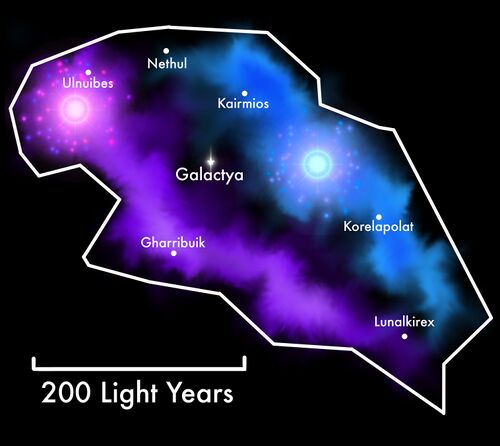 Overview of the Celestial Empire Of Galactya | |
| Motto | "With the Comet and eachother, all else shall follow!" |
| Founded | 9698 BBT |
| Location | Sector A1-0 |
| Capital | Galactya |
| Key worlds |
|
| Population | 81.498 trillion (12.225 virtual, 69.273 embodied) |
| Head of state | Karheismas Of Galactya Nixhoeils Of Galactya |
| Head of government | Karheismas Of Galactya Nixhoeils Of Galactya |
| Major species | Galactyans Drakari Sosa Carsicoid Synthari Yapatha Kri’ghal Amicem Terrans Edhelerim Silefrim Medumanns |
| Language | Galactyan |
| Military | Galactyan Armed Forces
Interstellar:
Interplanetary:
Planetary:
|
| Enemies | Technocratic Federation Of Sereniani |
| Alliance Membership | Coalition Of United Stars |
| Currency | Galyl (≾) |
| Official Religions | Official Galactyan Religions |
The Celestial Empire Of Galactya (Galactyan: "Ouremeis Yhurnoa Qyt Galactya"), more commonly referred to as the Galactyan Empire or just Galactya, is an ancient interstellar Archailect Empire located in the West of Sector A1-0.
Etymology
The word "Galactya", used for the Empire, the species' designation and it's homeworld, derives from an ancient Galactyan word, "Gællektiä", which translates to "Celestial". While the now current word for the adjective celestial is "Ouremeis", "Galactya" has remained detached from it. This lead linguists to speculate that Galactya is only part of a complete name for the Empire, which got partially lost during the Genetic Revolution. However, after the old Imperial Archives that contained all data prior to the revolution were unlocked, it was revealed that this was not the case. Galactya was always the main name of the Empire, and due to this various cultural movements detached it from the rest of the language, gradually transforming it from a common noun to a proper name.
History
The PreEmergence Era
The PreEmergence Era is the longest period in Galactyan History, lasting around 47 million years and ending in 9712 BBT. This Era covers the incredibly long timespan between the emergence of the first proper Galactyans, and the arrival of the Genesis Comet. Initially, Galactya hosted a very unstable biosphere, due to increased seismic activity caused by the tidal effects of the three moons, coupled with a general period of fluctuation in Crus' luminosity. Current simulations suggest that this instability had been occurring in Galactya for far longer than the birth of the Galactyans, with models placing it's start anywhere from 700 to 500 million BBT. These fluctuations made it so that the species on the planet were extremely competitive, with symbiotic species mostly existing only in the oceans. For 45 million years, the Galactyans had to survive in an extremely competitive environment, while the planet shifted from being covered in equatorial glaciers, to polar jungles. This severely halted the Galactyans' development as a species, and even with an intellect comparable to that of modern day Terrans, they still weren't able to advance as a civilization. The PreEmergence Era can be divided into three parts: The Early, Middle and Late PreEmergence.

The Early PreEmergence
The Early PreEmergence, is the first period of Galactyan pre-history, starting around 47 million BBT, and ending 25 million years later, in 22 million BBT. The Early PreEmergence saw the birth of the first true Galactyans, known as Alpha-Galactyans (due to them being the base and now non-existing version of current post Revolution Galactyans), who split off from the rest of their evolutionary branch and quickly developed primal forms of sapience. It is theorized that Alpha-Galactyans evolved between temperate and tropical zones in high forests in the southern equator, but were likely pushed of said environments due to predatory competition and brutal environmental shifts that ancient Galactya was characterized by. Probably due to the absence of trees on which to climb and the presence of tall grass covering all the fields, Galactyans took on a bipedalism, therefore getting a notable advantage over the other predators who used surprise as their main form of attack.
Due to Galactya's environmental instability, from 42 to 38 million BBT the planet was undergoing a phase of extreme global warming, also known as a Great Heat Age, with deserts growing to the middle of previously arctic zones. Therefore, the Alpha-Galactyans had to migrate south to escape the ever-growing deserts, but still becoming much more resistant to higher temperatures. The forced migration and heat increases created an heightened competition in the biosphere, therefore putting an higher evolutionary stress on the Alpha-Galactyans and further advancing their sapience.
After the Great Heat Age ended and the planet's climates settled in their new form, the concentration of emerged lands at the geographical poles, caused the central strip of ocean to fuel the growth of titanic anticyclones, that traveled backwards against the planet's rotation and devastated the equatorial territories, including the original environment of the Alpha-Galactyans. This phase of increased atmospheric activity lasted 3 million years, form 37 to 34 million BBT, and is known as a Great Storm Age. All the superficial species that inhabited said zones were again forced to migrate polarwards in the intact temperate climates, including the Alpha-Galactyans: this caused yet another increase in competition for the resources of said areas, fueling the Alpha-Galactyan's xenophobia and improving their problem-solving skills.
The Great Storm Age was then followed by a phase of extreme global cooling caused by one of Crus' short phases of stellar dimming, known as a Great Ice Age, that lasted for 5 million years, from 34 to 21 million BBT. The Ice Caps grew more and more, eventually covering everything but a thin strip situated at Galactya's equator: the emerged land available in this area was much smaller than the one present in the previously temperate and arctic zones. Similarly to the previous Heat Age, competition grew, many species went extinct and Alpha-Galactyan intellect grew. These three Great Ages than repeated until the very end of the Middle PreEmergence, following Crus' dimmings and brightenings.

The Middle PreEmergence
The Middle PreEmergence, is the second period of Galactyan pre-history, starting around 22 million BBT, and ending little under 22 million years later, in 29000 BBT. The Middle PreEmergence saw Crus' complete stabilization, with it's fluctuations first becoming longer by several million years. The Middle PreEmergence saw only three Ages: an Heat and Ice Age both lasting around 15 million years, separated by a Storm Age that lasted less than a million.
The Middle PreEmergence however is mostly notable not for the progressive environmental stabilization, but also for the final development of Galactyan sapience: around 3 million BBT, due to causes still not fully understood, Galactyans expanded their previously underdeveloped capabilities for abstract thought, creativity and introspection. This theory is backed up by the discovery of cave paintings and other simple artifacts dating back to approximately 2.8 million BBT. These artifacts bore various representations, like hunting scenes, landscapes, and even the first confirmed constellations. It is even theorized that some of the represented events might coincide with events of xeno history like planetary destructions, passing starships, and supernovae. However, these theories are yet to be confirmed, as none of them seem to line up with the histories and missions of any known alien species.
At the very end of the Middle PreEmergence, around 31000 BBT, Crus finally stabilized, ceasing it's fluctuations after a final weak Ice Age. While the three satellites still caused an higher rate of earthquakes and tectonic activity than other telluric planets in similar orbital configurations around their stars, the biosphere very slowly settled in a solid state over the course of approximately two millennia, the climate zones settling completely for the first time in hundreds of millions of years. The stabilization caused a rapid increase in the amount of available resources, bringing forth the prospering of all links of the food chain. The stable temperatures and amount of sunlight allowed plantlife to grow enormously, increasing the amount of prey animals on which the predators were able to feast, boosting their numbers as well. Additionally, the increased tectonic and volcanic activity brought high quantities of magma enriched in iron, magnesium or other metals, fast tracking the metallurgic revolution of early Galactyans.
The Late PreEmergence
The Late PreEmergence, is the first period of Galactyan history, starting around 29000 BBT and ending little over 19 thousand years later in 9698 BBT. After the final stabilization of Crus and consequently of the planetary biosphere, Galactyan civilization properly started in it's most primal forms around 29000 BBT. Because of the incredible hardships faced by the species during the Early and Middle PreEmergence Era, natural selection caused them to develop an higher affinity to cooperation with one another, and some of the strongest xenophobic instincts ever seen in the Sector, which will be extremely important in thousands of years when the species will become spacefaring. While more inclined to work with eachother, cultural differences in each group lead their xenophobic instincts to prevail, often leading to conflict and bloodshed, characteristics that marked most of Galactyan History.
The first groups of Galactyans who became sedentary and developed agriculture did so around 29000 BBT. This lifestyle quickly spread through the neighboring territories, becoming the "norm" for most of the civilizations of the period around 28000 BBT. By 26000 BBT, the first animals were domesticated, and two thousand years later, around 24000 BBT, Galactyans entered their version of the Bronze/Iron Age, relatively sooner compared to other species.This was thanks to the increased tectonic and volcanic activity bringing much more metals to the surface than on other planets, giving Galactyans much greater access to metals that would normally be much more difficult to acquire. Societies flourished, with various cities and city-states becoming centers of political power and, most importantly, trade, which became widespread around this period. Around 23000 BBT, the first forms of full writing systems were invented, and soon became widespread throughout the globe. It is in this period that Thathel is formed, the first actual Empire in Galactyan History. Other nations soon follow, each with their own form of governance. While the spread of knowledge and the amount of resources increased incredibly through this period, the signs of Galactyan xenophobia started showing through distrust or outright hatred for the other states. Tensions soon rose, and by 21000 BBT, the first true wars break out. From this point forward, even single years of regional piece will be uncommon.
In the post-atomic phase of this Era, Galactya was divided into five planetary superpowers: Arthalames, Unnoaske, Lulaspina, Gherovanja and Quwerosnit. These five nations, after decades of minor conflict, had reached a sort of political balance, resulting in the first period of Global Peace ever seen on the planet. This peace, however, was destroyed in 9712 BBT, with the arrival of the Genesis Comet on Galactya. After tracking down the mysterious object, which had crashed into the planet's biggest sea, it took four years for Galactyans to discover the Comet's capabilities. While the scientists who discovered them tried to keep them hidden to the governments, the information leaked, and quickly spread to all corners of the globe.

The Global War and the Moonfall
After discovering that the Comet, thanks to it's ability to transmute matter, could be used as a weapon of mass destruction, a Global War started and lasted until 9701 BBT, in which the five global superpowers turned on each other in an attempt to get possession of the Comet. This was for various reasons, but the central motivation behind obtaining the Comet was the national desire of establishing an eternal technological superiority over the other surrounding powers, allowing the possessor nation to obtain global unification. Another reason that drove the conflict was that the weapon of mass destruction could be used as an incredibly effective deterrent, that would discourage all other nations to wage war or anger the possessors. The conflict alone, the bloodiest in Galactyan History, caused the deaths of around 482 million of the then 8 billion Galactyans. Hundreds of cities and towns were ravaged and destroyed, with the remaining ones struck by poverty and paranoia as the national systems started failing. Likely due to a bomb exploding near the Comet during the war, it was almost fully activated: because of this, the weapon it had been built into malfunctioned, destroying Galactya’s second biggest moon, Estellia. The celestial body was converted it into millions of small fragments, that subsequently rained down on the planet's surface, destroying cities, raising the global temperature, causing incredible amounts of environmental damage and halting production chains all across the globe. This resulted in the deaths of another 394 million Galactyans. After this though, the various nations on the planet, both because the environmental changes were forcing them to, and because the deaths of more than half a billion people were a clear sign that the war couldn't continue, started collaborating and in little time, in 9698 BBT, they decided to fuse into a single governing body for the entire planet, thus forming the Celestial Empire of Galactya. The leaders of this newborn nation were chosen after the first Global Voting from a list of candidates containing members proposed by the governments of the five nations. The first Emperor and Empress of the Galactyan Empire were Heteneril Maentasi and Oppelavim Furthaller, founders of the IPEP program and the ones responsible for Galactya's first step into the stars.
The First Colonies & the Interplanetary Empire
After stabilizing itself in 9670 BBT, the newborn Empire started IPEP, the InterPlanetary Expansion Program. It's first target was Allunia, which, 20 years later, became home to the first extra-planetary colony. In 9640 BBT, instead, the Program was redirected to Galactya's brother planet, Idell. After being colonized and mostly terraformed, the planet became widely populated, reaching the same level of greatness of Galactya. However, relations soon soured between the two planets, with Idell wanting independence from Galactya. This lead to a series of political, social and armed conflicts that caused the deaths of other millions of citizens, and were eventually completely repressed by Galactya around 9380 BBT. It is speculated that current culture of Imperial Trust started during these exact wars, through propaganda campaigns organized to keep the citizens from deserting their Homeworld. With the technological advancements and workforce of the two combined planets, the Empire colonized and terraformed the other planets in the Crus-Lux system with exponential speed: first the Inner Telluric Planets, then the moons of the Gas Giants (and eventually the giants themselves, by building floating cloud cities in modified atmospheric layers) and at last, the Outer Telluric Planets. Relations between the older worlds like Galactya and Idell would commonly get sour with the newer and farther away colonies, often times leading to sociopolitical divides within the Empire. For hundreds of years (approximately from 9300 to 8900 BBT, for a total period of four centuries), there was a deep cultural divide between the inhabitants of the Inner Telluric Planets, who called themselves Inners, the Asteroid Belt, who called themselves Belters, the Gas Giants, who called themselves Gigantines, and the Outer Telluric Planets, who called themselves Outers. These cultural differences stemmed from a variety of factors. The Inners experienced higher standards of living and more decadent lifestyles, the Belters often had to work much harder, the Gigantines had an higher technological advantage but a lack of resources, and Outers would often act independently due to their remoteness. Like with Idell, these differences often sparked conflicts and acts of boycotting between the groups, leading to short-lived skirmishes all across the system. This national instability worsened to the point that, in 9066 BBT the Gigantines declared themselves independent, briefly seceding from the Empire to form the Gigantinian Moons Republic. Fearing of the threat their higher technology posed, an unlikely alliance arose between the Inner and the Outers which, together, defeated the Republic and forced the Gigantines to again become part of the Empire. After this, a wide propaganda campaign was organized by the Empire to promote national unity. While initially obtaining little to no success, the invention of Gravity Plating and notable advancements in Hydroponics saw a large increase in living conditions throughout all colonies, with Belters now having living standards similar to the Inners. This caused the propaganda campaign to gain a lot more success and traction, eventually completing it's purpose. The now socially and politically unified Empire finished colonizing the last celestial bodies of their star system and, after more than 800 years, in 8870 BBT, IPEP was finally dismissed.
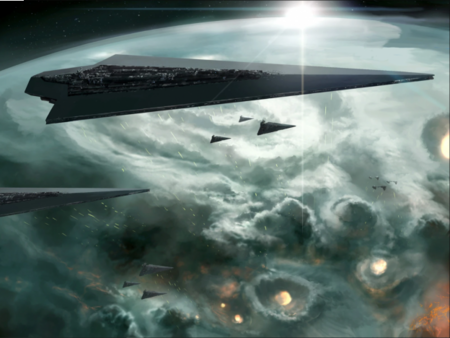
Era 1 - The Era Of Steel
In 8828 BBT, 870 years after the founding of the Empire, Galactyans invented a primitive version of the current Ringular Gravity Warp Drive. This is considered to be the official start of Era 1. Around 30 years after this invention, the first Interstellar Galactyan colony was established on the planet of Gwinthera, one of the planets of the star system Kasthartye. In a span of 1280 years, Galactyans colonized numerous star systems, colonizing planets and slowly terraforming them. Due to their rapid and notable expansion, in 7648 BBT Galactyans made first contact with another spacefaring race, known as the Melaneans, who after centuries of division, had reunified into the Melanean Federation. This alien state, after discovering the great numbers of lush and already terraformed worlds the Galactyans inhabited, decided to wage war against the Galactyan Empire to get control of the resourceful colonies. The conflict that followed, known as the First Interstellar War, lasted from 7647 BBT to 7506 BBT, caused the deaths of hundreds of billions of Galactyans and Melaneans, and the destruction of two entire planets. The war also resulted in a great "boom" of technological advancement that mainly interested weaponry and defense systems, but that also heavily affected other areas. After the incredible damage suffered by both nations after the war, and the loss of an actual reason to keep fighting on the Melaneans' part, the two species decided to sign a peace treaty, known as the Peace Of the Nebulae, in which they both promised to remain in their own territories and expand in the opposite direction. While the war was incredibly bloody for the two nations, the cultural effects it caused were able to partially free the Galactyans from their strong xenophobic tendencies, and make the Melanean Federation less militarized. But, after around 80 years, the instability caused by the heavy losses caused a total failure of the Melanean economy, reducing the population to around 23 billion Meleneans and forcing them to ask the Galactyan Empire for help. Galactyans, thanks to their reformed culture, accepted their request, and allowed them in their colonies. Initially the two populations distanced each other, but thanks to various programs organized by the Empire they soon began to integrate. Due to this newfound unification though, a new problem arose: as interspecies relationships started to become more and more common, their inability to have children became apparent. To solve this, biologists began working on a way to change the DNA of the two species to make them suitable for reproduction. This lead to continuous and exponential advancements in the field of bioengineering (referred by the Galactyans as "Genetic Manipulation"), initially researched to better the integration between the two alien species, but eventually surpassing their original purpose. This advancements caused great cultural shifts in the Empire, bringing forth the Genetic Revolution, what can perhaps be considered as the most important period in the entirety of Galactyan history, as it is the one responsible for shaping the nation as it is today.
The Genetic Revolution
Officially starting in 7368 BBT with the discovery of Genetic Manipulation, the Genetic Revolution lasted for 952 years, officially ending in 6416 BBT. During the Revolution, Galactya lost all interest in expanding the Empire's territories, instead completely focusing on developing and testing the limits of Genetic Manipulation and Terraformation, developing an almost fanatical obsession with the two sciences. Welfare was also highly prioritized, and the incredibly excellent life conditions on Galactyan colonies lead to a sharp increase in population numbers, which skyrocketed from 120 billion to 540 billion. Even though expansion was completely halted, a new faster and less expensive version of the Ringular Gravity Warp Drive was also invented, together with a more primitive version of Rainbow Shielding and the Genesis Generator, which remains a core component of bigger Galactyan stations and warships to this day. During this period, Galactyans also started to grow disgusted of their bloody history and of their xenophobic instincts, which, even when tamed by their pacifist culture, still proved to challenge their integration with their Melanean friends. Therefore, they decided to do something unprecedented. Using their new technologies, they started to modify their own anatomy, and to forcefully diversify their species into many, completely different from their original form. They did this to ensure their future generations a more peaceful and prosperous future in the Galactic Stage, to follow through with their fanatic obsession and fascination with the new sciences, and to spite their ancestors.
Era 2 - The Era Of Dominion
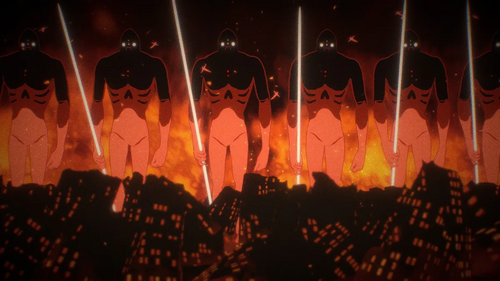
Due to the excessive increase of population, which was temporarily solved by building numerous orbital stations (something which still continues to be done to the present day), expansion programs were quickly restarted in 6416 BBT. In 2840 years, thanks to the great amount of progress and accumulated machinery built and put in storage during the Genetic Revolution, Galactyans quickly and efficiently colonized and terraformed a great number of planets and moons, conquering more than 16000 star systems. It was also during this time that, in 5231 BBT, due to the sharp increase of Galactyan colonies and their population, that the Council Of Clades was established. During Era 2, the Empire's Population grew even more than during the Genetic Revolution, passing from billions, to trillions. By 4649 BBT, the population had grown to 7.36 trillion and would reach 10 trillion in 4122 BBT.
In 4023 BBT, Galactyans made first contact with another spacefaring species in the Region, known as the U'Lnuib, who were less advanced and their territories smaller than Galactya's. The two Nations initially entertained peaceful relations with each other, but the wave of innovative ideals in the aliens' society brought by the first contact worried the aristocratic U'Lnuibian ruling class; fearing that they might loose their power, they decided to wage war against the Galactyan Empire. This started the Second Interstellar War, which lasted from 3876 BBT to 3794 BBT. The war was slow, but it's outcome was certain: the U'Lnuib, having severely underestimated the power of the Galactyan Empire, were completely unprepared, and their worlds could not resist to the Galactyan conquering. It should also be noted that this was the first war in which the Starlight Warriors were deployed on field, proving to be excellent bioweapons of mass destruction. While a good part of the alien population supported the war, many opposing factions formed in their Star Nation, advocating for the end of the conflict and for peace with the Galactyan Empire. At the end of the war, these factions were spared, and immediately integrated in the Empire; the rest of the population, instead, suffered a much worse fate. Their bodies were genetically modified en masse, reshaped to only be able to survive in gravity-devoid environments; immediately thereafter, they were enslaved and forced to work in asteroid belts for the Galactyans, mining and collecting resources for colonization and terraforming projects. The U'Lnuibian slaves were then liberated and re-integrated through genetic manipulation in 3408 BBT after an Empire-wide voting. After this the situation in the Empire remained relatively stable, technology advancing and the Galactyan colonies growing in number, as well as the population.
⪼First Contact With Calerost
In 342 BBT, Galactya made an accidental first contact with a ship of the Star Empire Of Calerost in the Korelapolat Star System. The ship's Mirial FTL drive malfunctioned due to the mass and density of the Nebulae interacting with Mirial Space, forcing the ship to make an emergency exit at the edge of the star system. Due to their inability to communicate properly, the first contact started with a battle between the ships of the two Empires at the edge of the star system, but after the arrival of a Calerostan StarBraker to the system, outfitted with a functional universal translator, the two factions were able to initiate diplomacy and cease hostilities. Due to Calerost's Miraline War ending around a century before the first contact, the Edhelerim were very distrustful of the Galactyans, due to their culture being centered around Genetic Manipulation, which they now considered an heresy against their religion. Regardless, in 338 BBT, the Empire managed to convince Calerost to allow them to send an ambassador to the Calerostan Capital, Ilanor. Gradually, while the cultural distrust still remained, the Galactyans managed to convince the Star Empire of their worth as allies, by reforming and greatly improving their medical system, enriching the nation and terraforming planets for them. Eventually, in 306 BBT the Galactyan Emperors signed an Alliance Treaty, known as the Treaty Of Celebar, with the Calerostan Emperor, cementing their relations and forming one of the oldest alliances in the Sector.
⪼First Contact With The Drakari Imperium
130 years after the Calerostan first contact, in 212 BBT, the Empire made first contact with a research vessel of the Drakari Celestial Imperium in the Kairelia Star System, who was on a mission of exploring neighboring space in search of other sentient species. Thanks to the first biologically adapted versions of the Calerostan Universal Translator, both parties were able to properly communicate from the start, and thanks to the peaceful behavior of both the Drakari and the Galactyans, they were able to directly engage in diplomacy on Kairmios, the major planet of the Kairelia Star System and one of the Imperial Major Worlds. Thanks to the more diplomatic and xenophilic natures of both nations, trade soon flourished between Galactya and the Imperium and in 203 BBT, another alliance treaty was signed, called the Treaty Of The Watchful Guardian.
⪼First Contact With Ferristia
In 156 BBT, Galactya made an accidental first contact with a stranded Ferristian exploration ship in the Ulnuirofons Star System. Due to the lack of any available Universal Translators in the system and to the pacifist nature of Ferristians, the aliens were temporarily abducted and brought into a Containment Station in orbit around Ulnuibes, the System's Main World. In less than a day, a Universal Translator was brought to the system, with the scientists in the station now able to properly communicate with the Ferristians, who were immediately released shortly after. Thanks to the friendly and pacifistic attitudes of both states, as well as the similarity of their genetics-centered cultures, an alliance treaty was signed just three years later in 153 BBT, signed on Ulnuibes and called the Treaty Of Ulnuirofons. Thanks to their cultural similarities, relations between Galactyans and Ferristians were very positive and solid from the start, so much so that Galactya took a sort of "Protector Role" for the alien nation.
⪼First Contact With Colonus
Era 3 - The Era Of Prosperous Chaos
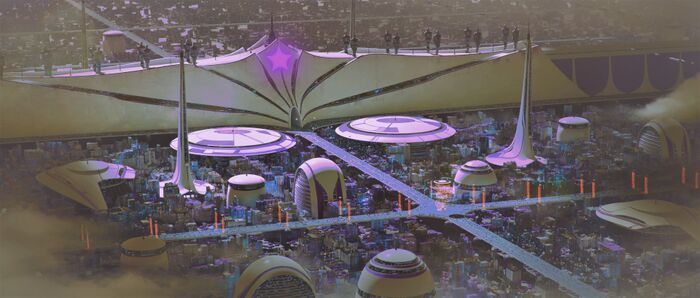
Era 3 officially began in 6000 P.E. ( which corresponds to both 1 and 0 BBT), and was celebrated by a 9 days long festival, which was also attended by Galactya's allies' rulers and members of their governments. Thanks to newly made diplomatic efforts, Galactya had managed to strengthen even more it's alliances, managing to alleviate import and export taxations and restrictions. Thus Galactya entered a real Golden Age, with knowledge spreading throughout hundreds of thousands of stars, trade bringing exotic goods in and out the Empire and travel being easy, fast and obtainable by all.
⪼First Contact With Emerald
Three months after the start of the year, Galactya made first contact with a stranded Emerald Warship in the Rhimus Star System. Due to the mass installation and public distribution projects of universal translators not having yet covered Quadrant 9, the two species were unable to properly communicate, temporarily engaging in conflict on the Warship. Thanks to a Universal Translator being fixed on the ship in little time, conflict ceased and the two species were able to engage in diplomacy. Due to the damage done to their ship and the start of a new wave of star creation in the Nebulae, the Emeraldians were brought to Galactya while their ship was being repaired, so that they could speak officially with the Emperors. Due to a incomprehension between the stranded crew and their Government, however, a fleet of Emeraldian Warships was sent to Galactya, believing that the crew had been imprisoned on the Capital. Thanks to the quick intervention of the Emeraldian Captain John Xanderson, the attack was stopped before the destruction of the Emeraldian Warfleet. Regardless of these incidents, peaceful relations were established between the two nations and soon, trade was established and Emerald established a partial alliance with Galactya, with actual peace treaties yet to be signed.
⪼First Contact With Trianar
Three more months after the Emeraldian First Contact, a Galactyan Warship that was testing a Mirial Drive got stranded outside charted space due to a miscalculation in the Drive's trajectory systems, and made first contact with the Holy Imperium Of Trianar, in the Katan Star System. Thanks to the ship's and crew's universal translators, the two nations didn't engage in conflict and diplomacy was started immediately. Because of Galactya being the first advanced large state that the Imperium has made contact with outside of it's territory, the Imperium refused to trade or engage with the Empire in any other way.
⪼First Contact With The Akropii Republic
After another three months, Galactya made contact with an exploration vessel of the Akropii Republic, in the Avekolych Star System. After a small incident due to misapprehensions on the Akropii's part, diplomacy was initiated immediately, and a crew of the synthetic aliens has been exploring and cataloging the Galactyan Empire's biodiversity and culture with official Imperial Permission since the first contact. Regardless of the Galactyans being the first advanced alien civilization met by the Akropii, they responded with trust and a relative calm attitude, which greatly appeased the Imperial Government. Due to the distance between the two nations, only a Non-Aggression Treaty was signed, but, as part of the treaty, the two nations had promised to try to engage in trading after an organized first contact with Calerost, in order to shorten travel distances.
The Wormhole War
⪼First Contact With Ryccia
⪼First Contact With Colestia
⪼First Contact With Kalgyul
⪼First Contact With Rehy
The Coalition War
Galactyan Alien First Contacts
The following table illustrate the nations Galactya has made contact with, the Era and date (both in the Galactyan and in the BBT System), the location, the initial and current relations with the Galactyan Empire and access to recordings and accounts of the event.
| Star Nation | Galactyan Date | Galactyan Era | BBT Date | Location | Star Nation Territory | Cause Of Contact | Initial Relations | Current Relations | Recorded Transmissions |
|---|---|---|---|---|---|---|---|---|---|
| Melanean Federation | 1268 P.E. | 1 | 7648 BBT | / | Interstellar Space | Contact by Expansionism | Hostile | Annexed/Absorbed | |
| U'Lnuib Hegemony | 3510 P.E. | 1 | 4023 BBT | / | Interstellar Space | Contact by Expansionism | Inhostile-Diplomacy | Conquered/Absorbed | |
| Star Empire Of Calerost | 5788 P.E. | 2 | 342 BBT | Korelaim Star System (Korelapolat) | Galactya | Incident | Hostility-Diplomacy | Allied | Chalerosto-Galactyan First Contact |
| 5868 P.E. | 2 | 212 BBT | Kairelia Star System (Kairmios) | Galactya | Exploratory Mission | Diplomacy | Allied | Drakari-Galactyan First Contact | |
| Ferristia | 5903 P.E. | 2 | 156 BBT | Ulnuirofons Star System (Ulnuibes) | Galactya | Diplomacy | Allied | ||
| 6000 P.E. | 3 | 1 BBT | Rhimus Star System (Nethul) | Galactya | Incident | Hostility-Diplomacy | Allied | Galactya - Union of Emerald first contact | |
| 6000 P.E. | 3 | 1 BBT | Katan System | Trianar (Hemmerhaldia) | Incident | Diplomacy | Acknowledgement | Trianarö-Galactyan First Contact | |
| Akropii Republic | 6000 P.E. | 3 | 0 BBT | Avekolych Star System (Avekolym) | Galactya | Exploratory Mission | Diplomacy | Allied | Akropii-Galactyan First Contact |
| Technocratic Federation Of Sereniani | 6000 P.E. | 3 | 0 BBT | Taivaallinen System | Galactya | Wormhole Discovery | Hostilty | Hostility | Sereniani-Galactyan First Contact |
| 6001 P.E. | 3 | 0 BBT | Kairelia Star System (Kairmios) | Galactya | Diplomatic Mission | Diplomacy | Trading | Ryccian-Galactya First Contact | |
| Common Republic Of Colestia | 6001 P.E. | 3 | 0 BBT | Noua Corinia | Union Of Emerald | Colonization Mission | Diplomacy | Allied | Colestian-Galactyan First Contact |
| 6001 P.E. | 3 | 0 BBT | Gyldly | Kalgyul | Diplomatic Mission | Diplomacy | Trading | CSK-Galactyan First Contact | |
| Rehy | 6001 P.E. | 3 | 0 BBT | Thellam Bok Globule | Galactya | Incident | Diplomacy | Rehy-Galactyan First Contact |
Astrography
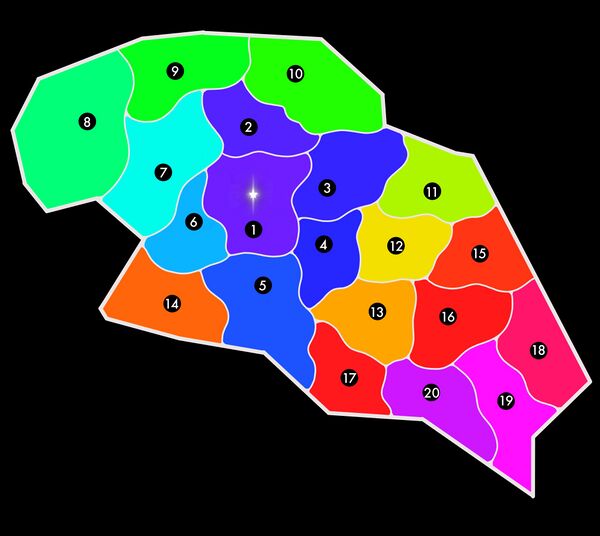
The Empire occupies a total space of approximately 10,260,000 cubic light years (10,265,234), and is comprised of around 32,000 star systems, all of which have been inhabited and terraformed where possible. It borders the Zelvan Regime and the Treecuu Star Empire to the South, the Star Empire Of Calerost to the East and Ferristia to the West. The Celestial Empire Of Galactya is situated in the middle of the western part of Sector A1-0, and is delimited by the Two Great Nebulae, respectively the Altay Cygnus and Hercules Borealis Nebula. These two formations are much much denser than regular nebulae, more akin to a rough but still traversable version of the Badlands. In both of them, on opposite ends of the Region, are located two Molecular Clouds, the Heaven's Tower and the Celestial Wall, which produce around 5 new stars every year. This means that Galactyan space is generally much denser than regular Interstellar Space, which leads to actual phenomenons of pseudo-Interstellar Weather. Of notable importance is also the Taivaallinen Wormhole in Quadrant 11, which directly connects to the Scientific Directorate Of Rosecordia's territories. This also means that while smaller than some other Regions of the Sector, it has approximately the same number of stars and planetary bodies, thanks to the higher density.
Imperial Core Worlds
The Core Worlds are the oldest planets, moons and habitats of the Galactyan Empire. All of them have very high populations and are very historically important.
A list of the various Imperial Core Worlds can be found here: List Of The Galactyan Core Worlds
Imperial Major Worlds
Thanks to being located near important trading routes or being the place where a first contact with another nation happened, other six worlds beside the Core Worlds and Galactya have become of relevant importance to the Empire bot in matters of economy and tourism. These are:
- Korelapolat, famous for the Calerost First Contact and for it's large exports of rare minerals from the barren world of Nuspi. Over the years it has become a major trading hub with Calerost.
- Kairmios, famous for the Drakari First Contact and for it's special Security Sensors Outpost. It's one of the oldest commercial nexuses of the Empire, and it had been far before the first contact. It is now an important trading hub with the Drakari Imperium.
- Ulnuibes, famous for the Ferristia First Contact, for it's exports of Nebulae Gases and for being the old capital of the U'Lnuibian Hegemony. It's now a major trading hub with Ferristia and an important Scientific Research Nexus. It has an orbital ring and a series of other orbital stations and habitats dedicated to the joint research.
- Nethul, famous for the Emerald First Contact and for it's exports of rare gases from it's system's gas giants, it also has a relevant position as the Main World of the Northern Frontier. It's now a major trading hub with the Union Of Emerald.
- Lunalkirex, famous for it's position as the Main World of the Southern Frontier and for it's rich mining operation. It has become a major trading hub with the Akropii Grand Republic.
- Gharribuik, famous for it's Orbital Weaponry Production operations. It has become an important internal trading hub and exports checkpoint.
Administrative divisions
The Empire is divided into 20 Quadrants, each containing around 1600 Star Systems. The Quadrants all have a certain degree of autonomy, but still have to report immediately to the Emperors. Quadrant 1 is considered the most Important Quadrant in the Empire, since it's there that he Capital Homeworld is located and it's there that the Quadrant Assembly meets at the start of every year. Quadrants 3, 8, 11 and 12 are the densest and most potentially dangerous areas of the Empire due to the presence of the Molecular Clouds, so public transport vessels going through those areas must be outfitted with special protection coating. The areas can still be traversed without extra protection, but the chances of an accident due to collisions or density fatigue are much higher.
In 0 BBT Quadrant 11, in which is located the Taivaallinen Wormhole, had been deemed a "high-danger zone" due to the events of the Wormhole War, with travel greatly restricted and with only necessary supply flights for the colonies closer to the Wormhole allowed. This ban had however been lifted after the Sereniani retreat and the start of the construction of the Belt Of Thaievia. The restrictions were abandoned a couple of months later.
Politics
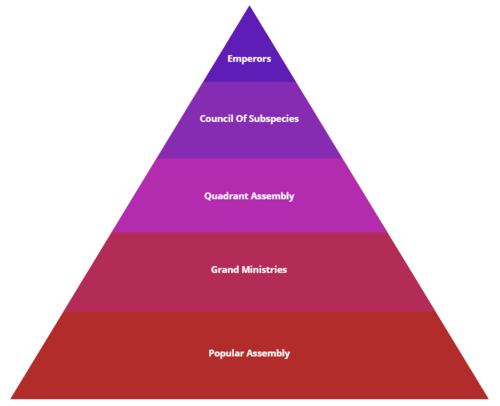
The Galactyan Empire, due to it's sheer size, maintains an incredibly centralized (by the standards of most other nations) governative and administrative system. This system, despite it's vastness, is relatively simple and streamlined, and is what allows Galactya the incredible level of efficiency that the Empire so proudly displays since it's foundation.
The Emperors
The Emperors are the two governing figures of the Galactyan Empire. As absolute monarchs, the hold all the power in the Empire, and each and every important decision must be approved by them to pass; the decisions and projects of lesser importance that can instead be took and started by Governors, Quadrant Representatives and members of the Council of Clades still have to be recorded and reported every month. While various aspects are overseen by both the Emperors, some are controlled exclusively by one of them: these aspects are agreed upon at the start of every new succession. As for the current Emperors, Nixhoeils controls Genetic Manipulation, Terraformation and Welfare, and Karheismas controls Colonization, the Military and Foreign Relations. It should however be noted that during the reign of the current Emperors, this role subdivision has become much less rigid and more formal, with the two often overseeing the aspects of their companion.
The current Imperial Couple is different from the preceding ones. In fact, both Emperors are entirely artificial, and were made in 1690 BBT after extensive testing of the then newly created Geviex (Genetic Vitality Extender). This makes the current Emperors much older than the other couples, who succeeded every 80 years due to the relatively short original natural lifespan of Galactyans.
The Imperial Couple resides in the Imperial Palace Complex on the Capital Planet of the Empire, Galactya, but they also have a secondary palace on the main worlds of each quadrant. The biggest Warship in the Empire, the Genesis Class "Glory Of Genesis" is also dedicated to them, and has been designated as their main travel vessel in case of a war with another star nation.
The Council Of Clades
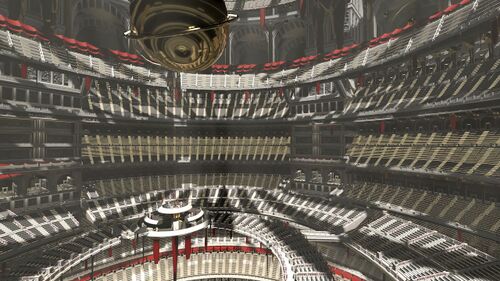
The Council Of Clades is the sociopolitical institution in the Empire that deals with national internal and external affairs, holding executive and legislative power together with the Emperors. The Council is nowadays mostly interested in the Ministry Of Foreign Relations, but does still hold authority over the other 6 Ministries. Founded in 5231 BBT, the Council has the role of drafting new laws, acting as an advisory body to the Emperors, and representing their thousands of species in the Empire. Despite holding both executive and legislative power, all their decisions can be vetoed by the Emperors if they so desire (however, this has rarely happened in more than 5000 years). The Council has a member for every Clade of the Galactyan Empire. The Council holds a meeting via communication every month, with a special meeting held in person at the end and start of every year, or for important or pressing situations.
The Quadrant Assembly
The Quadrant Assembly is the sociopolitical institution in the Empire that deals with internal affairs concerning singular Quadrants, Star Systems or Colonies. The Assembly holds authority over all Ministries except for the Ministry Of Foreign Relations. Founded in 6214 BBT, the Assembly has the role of coordinating the terraformation and colonization efforts of the colonies in the Empire, overseeing the production of individual systems, exposing requests by singular Governors and reporting everything to the Emperors and the Council Of Clades. The Assembly is divided into three groups: the High Assembly, made up of the Quadrant Representatives, the Middle Assembly, made up of the Stellar Governors, and the Low Assembly, made up of the Planetary Governors. As of 6000 P.E. (0 BBT), the Assembly has 20 Quadrant Representatives, 5215 Stellar Governors and 31920 Planetary Governors. The Assembly meets on Galactya at the start of every year in the Assembly Hall, a large spherical building located in the Middle Plazas of Galactya's Diplomatic District. Other special meetings held via holocommunication for emergencies or in person for important or pressing situations.
The Quadrant Representatives
The Quadrant Representatives are the highest government functionaries (apart from the Emperors) who have direct control over Imperial Territory. Quadrant Representatives hold executive power over the entire Quadrants which they govern and represent to the higher layers of Government, gathering and coordinating all the administrative data from the thousands of Star Systems in their quadrants, ranging from production overviews, to commercial transfer, to tourism and migration. Like the Stellar Governors, Quadrant Representatives can request the military intervention of the Galactyan Armed Forces in specific areas or in specific Star Systems. All Quadrant Representatives gather as the High layer of the Quadrant Assembly, acting as the most important government sublayer dedicated to territorial governance and administration, with all Stellar and Planetary Governors reporting to them.
The Stellar Governors
The Stellar Governors are the high government functionaries that are responsible for the coordination, administration and representation of individual Star Systems. They possess executive power over all colony worlds in their systems, and are made the Planetary Governors of said System's Main World, the most developed and inhabited one. Stellar Governors can request aid from other Imperial Systems, as well as military intervention from the Galactyan Armed Forces. Each Stellar Governor acts as the guide and representative of the System's other planetary governors in the Quadrant Assembly, as well as in layers of Higher Government. All Stellar Governors gather as the Middle layer of the Quadrant Assembly, and report directly to the Quadrant Representatives.
The Planetary Governors
The Planetary Governors are the high government functionaries that are responsible for the coordination, administration and representation of individual worlds. They possess executive power over their assigned colonies, and oversee all aspects of orbital production, infrastructure and affairs concerning their citizens. Each Planetary Governor reports to the Stellar Governor of their colony's Star System, who will expose their requests and reports along with their other sibling colonies. All Planetary Governors gather as the Low layer of the Quadrant Assembly, and while they normally report to their Stellar Governors, they can report and expose their requests directly to the Quadrant Representatives, if they wish to do so.
The Nine Grand Ministries
The Nine Grand Ministries are the organizations that coordinate and administrate the entirety of the Galactyan Empire. Each Ministry is represented and directed by a Grand Minister, who has the task of carrying out the decisions taken by the higher governing bodies such as the the Emperors, the Council Of Clades and the Quadrant Assembly. Each Ministry, like in many other foreign nations, is assigned a specific aspect of the Empire's governance and administration, that it will have to overlook and coordinate. The Ministers can either be appointed by the Emperors, or be elected by the members of the Quadrant Assembly and the Council Of Clades in a supermajority vote. The nine Ministries are all located in large buildings arranged in a ring-like configuration around the Imperial Palace, in the homonymous complex located on the capital Galactya. Inside each of these structures is located a supercomputer terminal directly connected to the planet's BioProcessing IntraLythoSphere, as well as the rest of the Empire's holocummunicative and computational network. Here is a list of the 9 ministries, describing their role in the Empire, and what minister coordinates them.
| Symbol | Name | Description | Minister |
|---|---|---|---|
 |
Ministry Of Foreign Relations | The Ministry Of Foreign Relations is responsible for coordinating the Diplomacy of the Empire, including trade routes, embassies, tourism and immigration. After the start of the first contacts, the previously little funded Ministry has gained a lot of importance, especially peaking after the founding of the Coalition Of United Stars. Together with the Ministry Of Infrastructure, the two ministries are part of the Combined Colonization Program. The Ministry oversees all active Galactyan Ambassadors, and is the first "response unit" in the event of a possible international incident. The head of this Ministry is called the Minister Of Foreign Relations. | |
 |
Ministry Of Defense | The Ministry Of Defense is responsible for coordinating the Galactyan Armed Forces, the main military body in the Empire. It also oversees, all Patrol Fleets, all Surveillance Radars and, together with the Ministry Of Economy, all weaponry production. Together with it's conuterparts in other member nations, the Ministry oversees the Combined Coalition Fleet. After the start of the Wormhole War on the Galactyan side of the Tunnel Of Invasion, the Ministry has also started Imperial Militarization Program, wanting to greatly increase the size of the Galactyan Military. The head of the Ministry is called the Minister Of Defense. | Xeralon Qerins |
 |
Ministry Of Justice | The Ministry Of Justice is responsible for coordinating the Judiciary Branch of the Empire. It is responsible for enforcing the laws stipulated by the Emperors or the Council Of Clades, and in order to do so oversees all law enforcement stations on the Empire's colonies. It also oversees the Fortress Prison Complex and the transportation of prisoners to the Yuln'Ebteanil SuperOrganism. The head of the Ministry is called the Minister Of Justice. | |
 |
Ministry Of Infrastructure | The Ministry Of Infrastructure is responsible for overseeing all Infrastructure in the Empire. It oversees the maintenance and construction of existing and new infrastructures, and coordinates the Hyperlane Net and all other forms of public travel, including planetary and interplanetary. Additionally, it often works with the Ministry Of Defense for the construction of defensive structures and the coordination of the Border Hyperlane Line. Together with the Ministry Of Infrastructure, the two ministries are part of the Combined Colonization Program. The head of the Ministry is called the Minister Of Infrastructure. | |
 |
Ministry Of Education | The Ministry Of Education is responsible for coordinating the Imperial Education System. It oversees all schools and universities in the colonies, and makes sure that every citizen receives a proper and complete education. Additionally, it's also responsible for the national broadcasting network Starlight News and for coordinating public events. Because of this, it often collaborates with the Ministry Of Foreign Relations for things such as international news coverage and interviews with foreign ambassadors or important figures. The head of the Ministry is called the Minister Of Education. | |
 |
Ministry Of Welfare | The Ministry Of Welfare is responsible for maintaining the Welfare of Galactyan citizens. It regulates the decisions made by the other Ministries that concern the Empire's citizens, and can intervene whenever said decisions would compromise their well-being. The Ministry regulates a large part of the decisions made by the Ministries Of Education, Economy and Infrastructure. However, it can also intervene on some decisions made by the other ministries. The Ministry Of Welfare also coordinates Care Centers and organizes most public events and national festivals, often collaborating with the other Ministries. The head of the Ministry is called the Minister Of Welfare. | |
 |
Ministry Of Health | The Ministry Of Health is responsible for coordinating the Imperial Healthcare System. It oversees all hospital buildings, emergency response units, medicine distribution and disease control. It's responsible for ensuring that each world under Galactyan rule has a proper and well-funded infrastructure that can be operational even under a health crisis. Importantly, the Ministry of Healthcare is also responsible for the distribution and overseeing of both Genetic Augmentations, and Proteic Reassemblies. The Ministry receives and evaluates the Genetic Augmentations created by the Ministry Of Technology, and will distributed if they can be classified fit for civilian use. The head of this Ministry is called the Minister Of Healthcare. | |
 |
Ministry Of Technology | ||
 |
Ministry Of Economy | The Ministry Of Economy is responsible for overseeing and maintaining the Economy of the Empire. It coordinates all industrial production done in orbital stations, and maintains the Imperial Treasury. The Ministry is responsible for the Empire's distribution of goods, the circulation of products, and the financing of various national and international projects. It also oversees the various trade routes with Galactya's foreign allies. The head of the Ministry is called the Minister Of Economy. |
The Popular Assembly
The Popular Assembly is the sociopolitical government body in which the citizens of the Empire can discuss, debate and share their opinions over legislature, foreign relations and various programs with the Higher Government . Despite officially lacking any sort of executive or legislative power, the Assembly still holds a lot of influence over the rest of the Government, thanks to the core belief and biological need of Galactyans in the high government to do reign and take decisions in the good of the people. The Higher Government often holds nation-wide Opinion Votings in the Assembly, in which the citizens can be briefed on and will able to give their opinion about a new law or decision that has been proposed by one of the above government layers. The Popular Assembly is mostly organized on the Imperial Holocommunications Network due to it's sheer scale (the total membership of the assembly generally includes most of the adult population), but smaller meetings on single worlds are relatively common.
Crime
Economy
Industry
Income, poverty and wealth
Technology
Infrastructure
Infrastructures And Megastructures In The Galactyan Empire

The Belt Of Thaievia
The Belt Of Thaievia is a defensive megastructure in current construction by the Empire around the Taivaallinen Wormhole, in order to replace the nuclear minefield left by the Sereniani before retreating to the other side of their wormhole at the end of the Wormhole War. Despite being placed there as a defensive measure to protect Galactya, the minefield was still detonated due to the necessity of refueling the wormhole's accretion disk. The structure receives it's name from the colony of Thaievia, the only colony who's shields were unable to resist the Sereniani's RKV attack. The Belt is perhaps the greatest megastructure project ever started by the Empire, greatly surpassing in magnitude the construction of Galactya's orbital rings or the gravity-plating of its two moons. The Belt is divided into two main Rings, themselves divided by an empty space in correspondence to the system's general orbital plane (in order to allow the disk's light to pass through and illuminate the various colonies in the system), with only support and connection frames crossing it. However, in the first construction phases, a thin Dyson Swarm will fill this space, both to aid in the construction of the Belt and to aid in the re-terraformation of Thaievia. The two main frames will be filled with large paneling that will serve as the structure's power source (eventually replacing the Swarm, who's materials will be re-used in the construction), gathering the light emitted by the disk, and as a defensive structure, hosting millions of attack drones. The main frame will instead host several large pieces of weaponry ranging from relativistic and superrelativistic missiles to Genesis-Based weapons, as well as various spaceports for the Empire's ships, or for requested allied forces. Despite being a defensive megastructure, the relatively positive first contact with the Scientific Directorate Of Rosecordia has put an eventual repurposing of the Megastructure into an inhabitable space, trading hub and highway to the Sector's East on the table. It has been estimated that the Belt, adding any help in construction by other Coalition Members, will be finished in 40/50 standard years. A maximum hypothetical deadline has been set around 6031 P.E. (around 50 BBT).

The Kantheana Matryoshka MicroNode
The Kantheana Matryoshka MicroNode is a Multi-Layered Megaconstellation of Orbiting Processor Elements constructed between 3473 and 3468 BBT, over the course of 5 years. The Micronode is part of a bigger web of Micronodes constructed around the Empire's Core Systems. Kantheana, the biggest gaseous giant in the Crus-Lux System, was chosen for a Pseudo-Stellification Process using a Neumann Reactor due to it's bigger surface area, which allowed the highest energy output possible. The MicroNode was built in response to the Empire's ever rising computational needs, which are to this day particularly bigger than other nations due to the Empire's heavily centralized nation and extremely socialist internal policies. It should also be noted that the pseudo-stellification of Kantheana made some changes to the long terraformed moons necessary, but also lead to the removal of Orbital Illuminators and greenhouse gases levels.
The Megaconstellation is divided into six layers, with orbits situated between the orbits of Kantheana's five major moons. Each Orbiting Processor Element is composed of a thin layer of Biocomputing Processors (which resemble animal neurons, despite being incredibly more powerful), covered in a Monopole-Doped Protective Coating, which serves both as a thermal coating and as a passive method of stabilizing the layer arrays. Each element's coating, depending on it's layer, has different resistance to temperatures, with the innermost processors having higher resistance to heat, and outermost processors having higher resistance to cold. With this arrangement, more than 75% of Kantheana's upwards light radiation, making it look much dimmer than it actually is from outside the gas giant's gravity well. The orbital elements are linked up in a single net that combines all of their computational capabilities. The net uses various stations in close orbit around Kantheana as data hubs, and as connections to the rest of the Empire's worlds.
The Micronode, combined with Galactya's BioProcessing IntraLythoSphere, handles the Empire's centralized data flow and organization, and is therefore one of the most crucial planets of the Galactyan Empire. The Micronode mostly deals with civilian and international surface data, such as trade routes, migration and tourism and the Empire's resources. It also serves as part of the National StarNet Web's central Hub.
Being one of the few pseudo-stellified gas giants in the Sector, and the only one in the West, the Kantheana Matryoshka Micronode has also become a very prominent tourist attraction, and in the last centuries, it's moons have seen a great increase in the Hotel and Hospitality Industry, with many luxury and independent restaurants and hotels being established there.
Demographics
Galactyan worlds
Over the course of it's near ten thousand years long existence, the Celestial Empire Of Galactya has colonized exactly 30120 planets, including telluric and gaseous planets, and 1700 moons. 94.4% of the colonized telluric planets have been completely terraformed, as well as 86.2% of the colonized moons. Large floating structures have instead been built floating in the atmospheres of gas giants to host cities and ecosystems. The remaining planets and moons that weren't fit for terraformation have either been repurposed as security and storage outposts, have been mined for materials or have become testing grounds for construction, science or military projects.
Galactyan colonies all have average temperatures ranging from 12 to 25 °C Celsius, atmospheres with an average composition of 74% Argon, 25% Oxygen and 1% Argon, large masses of water and a standard rotation period of 24 hours thanks to Orbital Gravity Generators, large movements of mass, mining operations and asteroid impacts. On planets which already hosted a biosphere prior to Galactyan inhabitation, cities are walled off, and exiting into the natural environment can only be done in designated ares, while a special permit is needed for normally isolated ones.
Population & Species
Despite the absolute majority of the population being represented by Galactyans, many other species, whether part of the Domain or not, are citizens in the Empire.
| Species | Star Nation Of Origin | Population | Citizenship | Details | |||
|---|---|---|---|---|---|---|---|
| Galactyans |
|
80 trillion | Full | The Children of the Fallen Star. | |||
| Drakari | NeoDrakari | 125 billion | Full | Most members of species hailing from the Drakari Celestial Imperium have undergone a Proteic Reassembly, thanks to multiple of their generations being born withing Galactya, and mostly being exposed to Galactyan Culture and Society. The only exception to this are the Drakari which, due to their millenary lifespans, still retain most of their original culture, and few of them have therefore been Reassembled. While most have been reassembled, many communities of "pure" individuals still remain, retaining most of their original culture, although with considerable Galactyan influences. Even the most "purist" of religions and ideologies have become much more tolerant in these groups, which live in harmony with their reassembled compatriots. All religions practiced by these communities have been officially declared Imperial Religions. Species from the DCI are mostly found on Kairmios and on neighbouring systems, but also have a notable presence in Quadrant 1. | |||
| Carsicoid | NeoCarsicoid | 92 billion | Full | ||||
| Yapatha | NeoYapatha | 20 billion | Full | ||||
| Sosa | NeoSosa | 18 billion | Full | ||||
| Kri'ghal | NeoKri'ghal | 15 billion | Full | ||||
| Sinthari | NeoSinthari | 2 billion | Full | ||||
| Terrans & Pacificans | NeoTerrans | 49 billion | Full | ||||
| 980 million | Pacificans hailing from the Union Of Emerald, due to them having immigrated to the Empire en masse over the course of two years, all retain their human culture, and therefore very, very few of them have undergone a Proteic Reassembly. However, Galactyan culture and society are starting to have their influence on them. All religions practiced by the Pacifican emigrants have been declared official Imperial Religions. Pacificans from the UOE are mostly found on Nethul and it's neighboring systems, but they also have a notable presence in Quadrant 1. | ||||||
| Amicem | NeoAmicem | Ferristia | 50 billion | Full | Almost all Ferristians have undergone a Proteic Reassembly, thanks to both Ferristian and Galactyan culture being based around genetic manipulation and improvement of one's biological capabilities. Ferristians are mostly found on Ulnuibes, but are still very spread out in the Empire. | ||
| Edhelerim | NeoEdhelerim | Star Empire Of Calerost | 2.5 billion | Full | As was once outlined in the Treaty Of Celebar, it was illegal for Galactyans to alter Edhel DNA in any situation without specific government approval. However, after some generations of emigrated Edhelerim were born completely immersed in Galactyan Culture, many began to request to be able to undergo a Proteic Reassembly and join their Galactyan Compatriots. After many public protests, the ban on genetic modification for Proteic Reassembly was lifted by the Calerostan Government, and while it still contained many limitations and included the excommunication from Calerostan Religion, millions of Edhelerim decided to join the Galactyan Domain. The first generation of NeoEdhelerim however lost their telepathic capabilities in the reassembly process, and because of that depression is widespread through their generation to this day, even though notable decreases have been obtained by social efforts from the Ministry Of Welfare. Subsequent generations of NeoEdhelerim however never experienced telepathy, and while they retain the honor of their Calerostan culture, they practice no religion and have no telepathic elements in their day to day lives, almost totally aligned with Galactyan culture. Many groups of "pure" Edhelerim still remain, practicing the culturally mixed Vistën religion and living in temple complexes built in the Calerost-inspired NewHope architectural style. Despite still being heavily religious, they have a much more tolerant view of genetic manipulation, and live in harmony with their genetically altered brethren. Notably, to show it's support for the previously excommunicated communities, the Galactyan Government declared Vistën the first official Imperial Religion. Edhelerim and NeoEdhelerim can mostly be found in the regions of the Eastern Frontier, with a notable presence around Korelapolat and in Quadrant 1. | ||
| Silefrim | 237 | Full | Silefrim almost exclusively live in Vistën Communities in order to be completely free and protected from the Calerostan Inquisition. Despite there being only 438 in total, 237 of them have emigrated to the Galactyan Empire in search of a better life, and all of them have succeeded in this task. Almost all of them can be found on Korelapolat, with a couple of individuals having established themselves in other Vistën Communities. | ||||
Rights, Welfare & Living Conditions
Religion
The Galactyans are irreligious by nature, and the concept of a belief in a higher being and/or existence was completely foreign to them until it was first introduced to them by the Star Empire Of Calerost. Still, no Galactyan to date has been able to be part of a religious belief system. Despite this, many religions have been declared Official Religions thanks to immigration from other nations. All religions are equally respected, and all members of said religions are equal under the law. Religious buildings are often paid for by the state, and can be found on many planets of Quadrant 1, as well as on Major Imperial Worlds and their neighboring areas.
Health
Language
Culture
Sculptors Of Nature
The vast majority of Galactyans live in environments that have been artificially created or modified by other Galactyans, whether those environments are re-engineered worlds or orbital habitats. Almost no Galactyans have ever experienced planet or biosphere centric disasters, such as earthquakes, hurricanes, extreme tidal waves, droughts or famine, and the few who have experienced them through safe protected habitats during the terraformation phases of their worlds. Instead, some of the greatest sources of fear and unease among modern Galactyans are disasters stemming from major technology misuse, technological collapses and all matters of sapient threats like raids and military invasions from other foreign civilizations. These events can be, and in many cases are, seen and dealt with in a way similar to how ancient Galactyans coped with major natural disasters. Thanks to bioengineering disease is also basically non-existent, and has been for thousands of years, with the only exceptions being particularly adaptive viruses or bacteria hailing from alien species, but even those are eradicated quickly and efficiently. Together terraformation, biotechnology, and the abundance of resources, make it so that Galactyans view nature as a blank canvas to be reshaped to fit their needs, ranging from colonization to simple art.
Morphological Freedom
A factor in both the diversity and relative peacefulness of modern Galactyan civilization is the near total morphological freedom that all Galactyans enjoy as a basic right. Biological and cybernetic alteration, augmentation, or complete redesign and replacement of the physical body is a trivial everyday occurrence, with such alterations being readily available to all citizens. Galactyans themselves, even before the Genetic Revolution, never had any prejudice nor started conflicts based around gender, sexuality or race. Instead, the only real conflicts arose from political affiliation and ideology, but even those died out centuries before the start of interstellar colonization. Modern Galactyans actually have difficulty grasping the concept of discrimination, and require great deals of time to understand how such a thing is possible in the civilized Sector.
Longevity
It is a known fact in the Sector that, thanks to their incredible advancements and capabilities in genetic engineering (which eventually consolidated in the Geviex in 1700 BBT), Galactyans extended their lifespans indefinitely, and became functionally immortal. This greatly reduced and almost eliminated the rate of gradual cultural change, while also greatly expanding the scope of what is considered a 'reasonable' timespan for a particular project or planning horizon. Decades, and eventually even centuries, are now seen as trivial amounts of time, whether to achieve a particular goal or consider the urgency of a particular challenge. Attitudes towards ever longer and more complex projects, often become extremely relaxed. A series of smaller activities or changes, or even long periods of minimal personality change, are still quite common. However, technological advancement has greatly increased in speed after the first contact with Calerost, and is still considered an important process, so much so that an entire Ministry is dedicated to it.
Due to the length of their lifespans, Galactyans often amass great amounts of knowledge. It's common for Galactyans to study multiple scientific fields, partake in hundreds of different hobbies and activities, and spend their lives travelling and experiencing as many new things as possible. This is also reflected in their careers, with many Galactyans working vastly different jobs belonging to vastly different fields in their lives.
Diversity
The Galactyan Empire is the most biologically diverse nation and society in the known Sector, with cultural diversity on the rise after the first contacts with the other alien civilizations. Thanks to genetic engineering, neogenics and the reassembly of xenosapients, the Empire is now home to more than a hundred different species, and many different cultures and religions. Galactyan architecture is built to be fit for all kinds of species, and upon the entry of a new species in the Empire, appropriate modifications are made if necessary. If architectural modifications are not sufficient, changes in the distribution and resource allocation chains are also carried out. It is not a surprise that Galactyans are often called fanatic xenophiles; however they now carry this title with honor, believing that cultural and biological diversity are important achievements for an interstellar society.
Post-Scarcity
The Galactyan Empire, since the Genetic Revolution, has been a Post-Scarcity Society. Definitions of wealth and poverty shifted drastically through the Eras, especially with the gargantuan increase in available resources and the establishment of state socialism and automation. Energy and materials are available to all, food (or the equivalent, depending on the species) is almost never scarce, and sophisticated manufactured goods are commonplace. This, coupled with the Universal Basic Income maintained by the Imperial Government, has a variety of secondary effects: poverty is completely non-existent and has been for thousands of years, and crimes of property (like theft, embezzlement and fraud) are also virtually extinct in most places (although some notable exceptions still exist). However, compared to what one might expect, even with their incredible abundance of readily available resources, Galactyans still enjoy the (ethical) accumulation of material wealth, expensive decoration, furniture and architecture, and the possession of historical and/or alien artifacts. Galactyan society is oftentimes called decadent for this (or outright "rotten and lazy" by some more xenophobic and critic foreign factions). Other signs of social status and wealth in the Galactyan Empire include performing rare and important occupations (not necessarily jobs), social connections, unique accomplishments, and extra-national travel.
Automation & Employment
All worlds in the Galactyan Empire have access to automation sufficient to match, and exceed, the capabilities of any working citizen. Automated manufacturing and extraction, robotics and non-sentient intelligent software have removed any need for citizen labor to provide for all physical or social needs. All citizens within the Empire receive a monthly Universal Basic Income of considerable proportions, rendering labor or working itself not necessary to sustain one's lifestyle. The Primary and Secondary Sectors are completely automated, while the Tertiary is, instead, mostly carried out by citizens. Teaching, finance, restaurant jobs, government positions and roles within the Imperial Fleet are some of the many positions where automation is virtually non-existent. Although citizens don't have to engage in gainful employment, Galactyan society is not one of non-stop idle leisure (although extended periods of such are quite common). To a greater or lesser degree within the Empire, citizens are encouraged to engage within their community, most notably in the arts and recreation. Committees form and disband on a constant basis, focused around the interests of their constituent members. While some committees, often termed "clubs" may last for decades or even centuries, often with a stable membership, others may form, carry out their intended function, and disband within a single Imperial day. Many applications exist to match a citizen with another person sharing their same interests, and many public spaces have been constructed to allow the recreation of said groups in public.
Core Values
Entertainment
Cuisine
Styles & Fashions
See also
- Galactya's ranking in the List of star nations by Population
- Galactya's ranking in the List of star nations by Galactic Development Index
- Galactya's ranking in the List of star nations by Astropolitical Influence Index
- Drugs